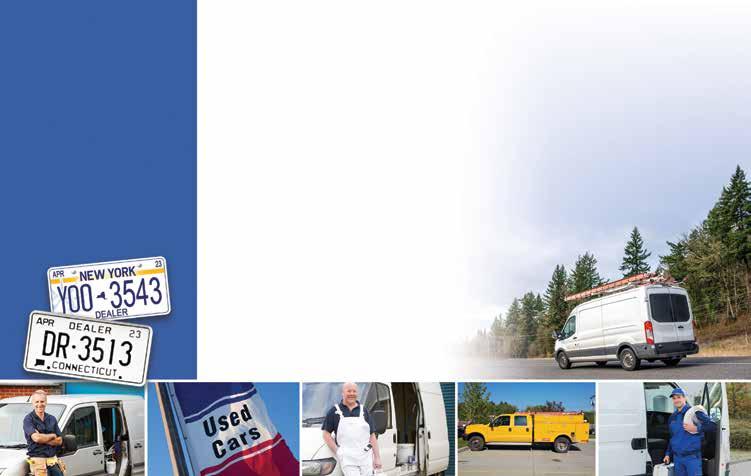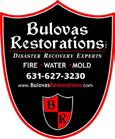It all starts with Create powerful, enduring customer connections YOU June 2023 • New York 9 Consider mid-career professionals 15 A culture of well-being 27 New hires have new expectations IN THIS ISSUE 9 Consider mid-career professionals 15 A culture of well-being 25 New hires have new expectations IN THIS ISSUE 9 Don’t shoot the messenger 25 Customer satisfaction 31 Carrier ratings IN THIS ISSUE PAGE 18



In a Competitive World, Experience Matters! Lovell Safety Management Co., LLC 110 William Street New York, NY 10038-3935 212-709-8600 | 1-800-5-LOVELL www.lovellsafety.com Win and Retain More Business with a Lovell Safety Group Over $1.15 Billion in Dividends Issued to Date Discounts up to 35% Call us for a Quote Today at 800-556-8355 Get a Quick Estimate by Visiting our Website at www.LovellSafety.com Lovell has been the leader in workers’ compensation insurance since 1936. Learn more about our unbeatable safety group programs for: • Building Metal Trades • Cleaners • Construction • Electrical Manufacturers • Hospitals • Launderers and Cleaners • Municipalities • Painters and Decorators • Paper Products Manufacturers • Retail Lumber • Roofers and Sheet Metal Workers • Truckers, Movers, and Warehouse people
18 It all starts with you Create
25 Customer satisfaction
An even more elusive goal in dynamic economic times
Statements of fact and opinion in PIA Magazine are the responsibility of the authors alone and do not imply an opinion on the part of the officers or the members of the Professional Insurance Agents. Participation in PIA events, activities, and/or publications is available on a nondiscriminatory basis and does not reflect PIA endorsement of the products and/or services.
President and CEO Jeff Parmenter, CPCU, ARM; Executive Director Kelly K. Norris, CAE; Communications Director Katherine Morra; Editor-In-Chief Jaye Czupryna; Advertising Sales Representative Kordelia Hutans; Senior Magazine Designer Sue Jacobsen; Communications Department contributors: Athena Cancio, David Cayole, Patricia Corlett, Darel Cramer, Anne Dolfi, Kordelia Hutans and Lily Scoville.
Postmaster: Send address changes to: Professional Insurance Agents Magazine, 25 Chamberlain St., Glenmont, NY 12077-0997.
“Professional Insurance Agents” (USPS 913-400) is published monthly by PIA Management Services Inc., except for a combined July/August issue. Professional Insurance Agents, 25 Chamberlain St., P.O. Box 997, Glenmont, NY 12077-0997; (518) 434-3111 or toll-free (800) 424-4244; email pia@pia. org; World Wide Web address: pia.org. Periodical postage paid at Glenmont, N.Y., and additional mailing offices.
©2023 Professional Insurance Agents. All rights reserved. No material within this publication may be reproduced—in whole or in part—without the express written consent of the publisher.

COVER DESIGN Anne Dolfi Vol. 67, No. 6 June 2023 June 2023 • New York
COVER STORY
powerful, enduring customer connections FEATURE
DEPARTMENTS
In brief 9 Tech 13 Sales 31 E&O 35 Ask PIA 41 Officers and directors directory
Readers’ service and advertising index
4
42
IN BRIEF
What customer experience (CX) is …
The impression your customers have of your brand throughout all aspects of their working with you.
What customer experience is not …
It is not just marketing. Marketing may get people interested in your agency, but their experience will determine if they remain clients.
FACTORS NEEDED FOR CX SUCCESS
1 COMPREHENSIVE MARKETING. COMPREHENSIVE MARKETING. Market your clients’ journey after they purchase their insurance policies, not the purchase itself.
Key strategies to consider:
Thank your clients
Provide tracking
Organize your customer support
Respond to customer reviews
Remarket
Optimize your post-purchase marketing
2 CUSTOMER PERSONA DEVELOPMENT. CUSTOMER PERSONA DEVELOPMENT. Understand who your clients are, what they need, and how you can help them.
Key points to consider:
Just of global CX practitioners
report that their customer persona development has been in place for three years or more.
Content preferences
Mobile behaviors
Purchase decision factors
Drivers of satisfaction (and dissatisfaction)
3 END-TO-END JOURNEY MAPPING. END-TO-END JOURNEY MAPPING. Visualize the process you need to accomplish a goal. Remember this changes over time.
Key factors to consider:
Think of your specific users
Think of your scenarios
Think of your goals
journey … make it a smooth one journey … make it a smooth one
4 PROFESSIONAL INSURANCE AGENTS MAGAZINE
CROSS SELLING ADDS TO THE JOURNEY
When it comes to developing your customer experience, you need to be proactive. Waiting for potential clients to find you won’t get the job done. You need to be proactive with your current clients, too.
Once you’ve sold an insurance policy to a client, you need to sell him or her on your value. If clients understand your value, they will be less likely to make future insurance-buying decisions on price, which will make them less likely to leave your agency for another one at renewal time.
A great place to start sowing the seeds of value is with cross selling.
satisfaction LEADS TO
Customer satisfaction directly impacts customer loyalty.
Make sure your clients are happy with the products and services you provide.
Customer satisfaction can predict future performance.
Happy clients are more likely to continue their relationship with you in the future.
Customer satisfaction can lead to referrals.
Happy clients are likely to share their experiences with family and friends.
TOP
7 REASONS TO EMBRACE CROSS SELLING
1
Revenue. Every agency employee has the power to generate opportunity. If you can sell more to your current clients, you can best protect them and help your agency grow.
2
Renewal. The policies that tend to take the biggest rate increases are monoline policies. Reduce those inbound calls with upset clients by educating them about their options to combine and save.
3
Better quality customers. When you have a cross-sold account, that client understands your value! The more clients who believe in value over price for insurance are clients worth keeping.
4
Ethics. It’s the right thing to do. When you see something not covered or underinsured, you must let people know so they can make informed decisions. They rely on us.
5
Because they need it. Often, clients buy the other policy from someone else. Why not you? If they can combine and simplify their lives, isn’t that reason enough to offer the option?
6
Self-esteem. Isn’t winning your clients’ other lines of business fun? Getting to “yes” means you have more self-esteem. You also hear more congratulations from agency leadership.
7
Keep the competition away. Who wants to be in battle with another agent? When you have all your clients’ policies, you can best advise them and keep that competition far away.
(You are not “too busy.”)
5 PIA.ORG
Improving customer experience amid the digital age
Denis Connolly, chief revenue officer, Brush Claims
One of the most common challenges that insurance professionals face when working with policyholders is the issue of communication barriers. While agents need to be available to their customers and responsive to their needs, they may struggle to keep up with requests—particularly when managing a large client base. In addition, customers may prefer to communicate via different channels (e.g., phone, email or chat), making it difficult for agents to manage all communication effectively. This can result in missed opportunities or misunderstandings, which can harm the client-agent relationship.
Along with the struggle of overcoming communication barriers, agents must depend on claims professionals to utilize the most efficient tools available. When digital solutions are disregarded, many agents are impacted by claim departments’ failure to keep up, which ultimately hurts the customer experience. Often, this is a result of the fact that carriers are having to juggle multiple independent programs to handle claims. It’s well-known that these programs do not communicate with each other without the cumbersome task of duplication or manipulation to do so. Regardless of the tools these firms add to their offerings, they still are limited. Offering a highquality customer experience means claims adjusters are calling on a suite of solutions that work seamlessly together to provide stress-free management, real-time analytics, and tech-advanced features (e.g., virtual photo scoping). And above all, we need to move toward a cohesive experience that does not start and stop at the beginning of the process but rather one that carries through to the end. When agents and claims professionals move toward their own individual goals, the gap between the two parties grows wider, ultimately leaving customers frustrated in the middle. For instance, when customers find they must pay their premiums in one portal, and then source an entirely new platform to submit a claim, a breeding ground for negative customer experiences is a result. Opportunities are missed, and policyholders begin shopping for new insurance options.
Also, digital tools can be a powerful asset for claims professionals in creating smoother processes between insurance agents and clients. However, it’s important to acknowledge that they can pose certain challenges. Common issues include difficulty integrating new tools with existing systems; a lack of training or understanding of how to use tools effectively; and potential
cyber security risks. In addition, insurance agents may face communication barriers with customers who are not familiar with using certain digital channels that adjusters have presented to them—leading to potential misunderstandings or missed opportunities. However, when both agents and claims professionals are aligned on tapping into digital tools, the customer can receive support and a consistent flow from beginning to end.
As mentioned, digital tools can play a critical role in helping insurance agents overcome communication barriers and time-management issues. Ultimately, these tech tools allow for an aggressive move toward virtual inspections and adjusting, which helps claims professionals provide timely information to your valued clients and—when the agent side is on the same page with utilizing digital tools—a seamless, positive client experience is created. It’s a win-win. While virtual inspections were once just a big idea, now they are a reality that is leveraged by those who are leading the way in stress-free insurance customer-service experiences.
Also, AI and machine learning are digital tools that adjusters are beginning to tap into—and although some may feel hesitant and worry that it will reduce the workforce—many understand that it will increase efficiency for both adjusters and agents, allowing more time to focus on tasks that must be handled with the human touch. AI has enhanced chatbots that are able to provide more robust responses to common questions, reducing client wait times, as well as agent workloads. This can save time and increase convenience for both parties. By using these digital tools, agents can streamline their workflows, improve productivity, and ultimately provide a better overall experience when partnering with claims professionals who also are committed to tapping into technology to better the client experience.
Connolly has held sales and corporate development positions at several Fortune 500 companies, executing multi-milliondollar acquisitions in addition to driving large incremental sales revenues. At Brush Claims, he works with the firm’s carrier strategic partners while building and establishing new key client relationships. He also oversees the sales, marketing, customer service, and client relationship management teams.
This article is adapted from “Improving customer experience amid the digital age,” which can be read in its entirety on PIA Northeast News & Media (blog.pia.org).
PROFESSIONAL INSURANCE AGENTS MAGAZINE 6 FYI


Proudly serving quick service restaurants Workers Compensation Insurance • No volume requirements • Competitive rates • Multiple options for premium payments • Open to Shock Loss/High Mods Send in your submissions today. For more information contact a marketing rep at 844-761-8400 or email us at Sales@Omahanational.com. [ Coverage in: AZ • CA • CT • GA • IL • NC • NE • NJ • NY • PA • SC Smart. Different. Better. Omaha National Underwriters, LLC is an MGA licensed to do business in the state of California. License No. 078229. “A” (Excellent) rated coverage through Omaha National Insurance Company, Preferred Professional Insurance Company, and/or Palomar Specialty Insurance Company.


WE PICTURE THE WORST FOR YOU. WHOLESALE BROKERAGE | BINDING AUTHORITY | EXCLUSIVE PROGRAMS JencapGroup.com
BRADFORD J. LACHUT, ESQ. Director of government & industry affairs, PIA Northeast

Don’t shoot the messenger
You are probably familiar with the turn of phrase Don’t shoot the messenger. It means not to blame the person delivering a message for the content of that message. Often, I think that all insurance agencies should have that sign up in their lobby or on their website, as a notice to customers. The independent insurance agent is the best—and often only—connection policyholders have to the world of insurance. So, when something happens to their policies, they are apt to blame any bad news on the messenger: their insurance agent.
With premiums and nonrenewals currently on the rise across almost all lines of insurance nationwide, how is an agent supposed to deal with delivering the bad news? All an agent can really do is help to explain the facts behind why policyholders are experiencing what they are experiencing. While the answer to that question is complex, as an agent you don’t have to tell the complete
story, only the most relevant to the policyholder.


Pump it up
Let’s start with the most obvious, at least for the policyholder, and that’s with inflation. That is a concept we are all painfully familiar with at this point. Inflation is the rate at which prices for goods and services increase. As I wrote in the March 2023 issue of PIA Magazine, inflation in America reached 20-year highs in
PIA.ORG 9 TECH
Steer Your Contractor and Used Car Dealer Risks to the Pros Turn to the folks that understand your clients’ businesses, deliver A- (Excellent) rated commercial auto and garage liability coverages, and provide the resources and support you need to achieve profitable growth. Business Auto Liability and Physical Damage • Contractors – Commercial Building, Electrical, HVAC, Painting, Plumbing, Roofing, Janitorial Services and more Garage Liability — Used Car Dealers • Dealer and Transporter Plates Writing in NY, NJ, PA, CT & OH* • Convenient Online Quoting • 24/7/365 Claims Reporting • Flexible Payment Options Contact us today: 516-431-4441 x3507 producer@lancerinsurance.com www.lancerinsurance.com * Please contact us for a list of available products and coverages by state
2022. Which means the cost of many goods and services were similarly high. Policyholders may ask how inflation impacts their insurance premiums when they still are purchasing the same level of coverage. Ignoring the fact that the risk may be underinsured now—a topic for another article—inflation means that the cost of replacing the risk, be it a vehicle, house or business is now more than it would have been during the previous policy terms.
Increasing interest (rates)
A policyholder might say, “Okay, I understand why inflation might increase premiums for policies that cover property, but what if I have a liability-
only policy?” Good question. That brings us to the next talking point: increasing interest rates.
The Federal Reserve is the central banking system of the United States, and in a grand sense oversees making sure the country’s economy continues to have sustainable growth. When the economy gets funny—like when inflation increases sharply—the Fed will use the main tool in its toolbelt to address it: adjusting interest rates. The Fed has been increasing rates steadily for the last year. Where there was 0% interest rate for much of the pandemic, interest rates currently sit around 5%.
How do interest rates impact premiums and risks that an insurance company will write? Here it’s time to acknowledge a hard truth: insurance companies are businesses and businesses exist to make money. It’s OK to admit that. America is a capitalist society; generally, profitability is encouraged. So, how do insurance companies make a profit?
EverGuard, The Best Long-Term Partner For Your RBT
EverGuard, is a superior Restaurant, Bar & Tavern market with 40+ years’ experience. Our continued longevity offering an uninterrupted market assures you will receive the best product underwritten by an AM Best “A” rated carrier without program interruptions.


EverGuard’s respected reputation in the RBT market speaks to our stability and reliability to provide industry-leading response time and customer service to our partner agencies.
•
Insurance companies make money differently depending on the state of interest rates and the economy. When interest rates are low, profitability comes from investments.1 Money is inexpensive to borrow, which makes the return on investing that money higher. Insurance companies will write more policies to take in more premium dollars, which they can turn around and invest. Even it if means paying out more in claims than a company takes in in premium.
However, the script flips when interest rates increase. When the cost of borrowing money increases, the return-on-investment decreases. Insurance companies are no longer looking to make money on investments. Instead, they are looking to make money on the risks they
PROFESSIONAL INSURANCE AGENTS MAGAZINE 10
Business.
is an EverGuard priority
Uncompromised program loyalty
• Exceptional service
•
Great coverages at competitive pricing with available A&B, Enhancement Endorsement & more
No limit on alcohol sales
Package Policy: Property, GL & Liquor Liability
Entertainment considered
Experienced & Professional Staff Isn’t It Time You Joined the Market Leading RBT Program? Bars, Taverns, Brewpubs, Comedy Clubs, Diners, Restaurants, Tasting Rooms… Michael Maher EverGuard Insurance Services VP, Business Development Michael@everguardins.com 1900 W. Nickerson St. Seattle, WA 98119 206.957.6576 | everguardins.com EverGuard does not offer or solicit the program in the states of New Hampshire, Connecticut or Vermont.
•
•
•
•
insure. To be profitable, an insurance company will be more sensitive to the cost of claims exceeding the premium received. Insurance companies address this in several ways, including increasing premiums or decreasing exposures by either lowering limits or canceling risks outright.

Introducing reinsurance
The last talking point is perhaps the one that is most unfamiliar to policyholders. Heck, it is unfamiliar to many insurance agents! That is the concept of reinsurance. While reinsurance is likely a foreign concept to policyholders, at least at a high level, is a relatively easy concept to understand. It mirrors the policyholder’s own insurance experience. Reinsurance is nothing more than insurance for insurance companies.
Insurance, at its base level, is a contract to transfer risk. In typical insurance settings, a policyholder agrees to pay a premium to an insurance company to transfer the risk of paying for a future loss to said company. Reinsurance is the same concept. An insurance company purchases reinsurance to transfer some of the risk of the future loss to another party.
Just like inflation and high interest rates have caused premiums for regular insurance to increase, so to have they made premiums for reinsurance increase. There are now fewer reinsurance dollars to go around to insurance companies. In turn, insurance companies will limit their exposure by being more selective in the risks they write, as well as how much they are charging for those exposures.
I am not naïve enough to think that talking about reinsurance and economic policy will quell the angriest policyholder. However, being able to understand—and more importantly explain—the reasons why a policyholder with no significant claims history is experiencing a 20% rate increase is critical. It allows you to not only deliver a message, but it will elevate you from merely a messenger to a trusted adviser.
Lachut is PIA Northeast’s director of government & industry affairs.
1 It’s appropriate here to mention that there is obviously a lot of nuisance to how businesses make money, which I’m ignoring for the sake of brevity and our collective sanity.
PIA.ORG 11
Please refer to actual policy for details. Policies are underwritten by Great American Insurance Company, Great American Insurance Company of New York, Great American Alliance Insurance Company, and Great American Assurance Company, authorized insurers in 50 states and the DC. Products not available in all states. © 2023 Great American Insurance Company, 301 E. Fourth St., Cincinnati, OH 45202 5637-AGB (04/23) Bow, NH 877.552.2467 aimscentral.co m TM FROM THE FARM AND RANCH PROFESSIONALS AT FIND A COVERAGE THAT APPLE-SOLUTELY MEETS YOUR NEEDS!













 JOHN CHAPIN President, Complete Selling
JOHN CHAPIN President, Complete Selling

How important is price when selling?
Price has been coming up a lot on my recent coaching calls with sales representatives, but there was one comment that compelled me to write this article. In a story related to a sale he made, a representative said, “I told the guy, ‘Look, you just tell me where the competition is, and I’ll cut my price to match it or beat it.’”
After instructing him to never utter those words ever again for the rest of his life, he came back with, “Why not? It’s an easy sale every time. All I have to do is make sure I’m the lowest price, and I’ll get the sale every time. Besides, this guy told me he buys solely on price so that’s the only way I’ll get the sale.” In the salesperson’s defense, he’s only been in sales for three months. That said, if I had a nickel for every time sales representatives—from newbies to veterans—told me they lost a sale because of price, or they couldn’t compete because of price, or used any other similar type of price excuse for not making a sale … well, I’d have a mountain of nickels.
The first thing I asked the sales representative was why we need him if all sales simply come down to price. If prospects buy on price, I could literally show up—having never met them before—with the equipment they need, ask what price they’re willing to pay, and then sell it to them right then and there for that price. Or, they could call the business, tell the receptionist what they want and what they want to pay, and the receptionist could take care of that transaction. If that’s the case, why are we paying your salary, commission, and expenses?
Next, I asked the sales representative if the prospect eats the cheapest food, wears the cheapest clothes, drives the cheapest vehicle, and lives in the cheapest house. If he or she does, the prospect might be a pure price shopper, but my guess is he or she doesn’t. Why? Simple, in any area in which he or she doesn’t simply buy the cheapest, the prospect sees the value in paying more. So, if the prospect saw value in your product, you, and your company, he or she would be willing to pay more for these products.
People appear to buy based on price
Here are a couple of other factors that may make prospects appear to be price shoppers.
First, price is the one thing on a proposal that’s in English. Your prospects do not work in your industry day in and day out, they don’t understand the subtleties, and they don’t know the true differences and value in features,
functions, and other variables between products, companies, and sales representatives.
Second, most of us have been conditioned to ask for a better price since we were little kids because we know salespeople are almost always willing to budge on price—at least a little. As a result—to maximize the price drop—the average prospects will tell salespeople they are strictly price shoppers and if they want the business, they’re going to have to give the maximum price cut.
The reality is, people know that you do get what you pay for, and they realize that products, companies, and sales representatives are different, but when price is brought up, what does the average salesperson do? He or she immediately cuts the price (as the representative in this story did).
It takes work
However, this leaves the prospects to think that maybe there is no difference other than price. I mean if there was, why wouldn’t the salesperson tell them why his or her product is more versus just cutting price? The reason is that the average salesperson is looking for quick solutions, and it takes work to learn the differences between what you offer and what the competition offers. It takes work to calculate the potential value and put that into a form that the average
PIA.ORG 13 SALES
prospects will understand and with which will resonate with them. Finally, it takes work to find out what’s important to each individual prospect, determine whether your product is right for a prospect, and then, if it is, articulate value in a compelling way. Most salespeople don’t want to do that hard work, it’s simply easier to cut price versus make the case for why someone should pay more for what you have.
Instead of focusing on price …
If you have two different brands of product, there are differences between them, which equals a difference in value and price. Even if you have the same exact product but it’s being sold by two different companies, you have a difference in value between the companies and the individual sales representatives. In either of these scenarios, you’ve got to know the differences and articulate those based upon what’s important to the prospect.
That said, is price a factor? Yes. Is it the biggest factor? Study after study shows only about 7% of the population truly buy on price alone. Ninety-three percent of the time, when you have a price issue, it’s because your product costs more, and you didn’t show added value that was equal to or more than the additional investment.
So, if you do your job correctly by building value and tying it to the prospects’ needs and desires, while price will still be a factor, it will only trip you up about 7% of the time. And by the way, you don’t want to deal with the 7% of the population who truly buys on price anyway because true low-price shoppers are a nightmare. They are never satisfied. They will call you and email you at all times of the day and night, on weekends, and during holidays, and your response will never be quick enough or good enough for them. They will show no appreciation for you, and they have zero loyalty. Even if you’ve been dealing with them for years, as soon as someone beats you on price, they’ll be gone.
On the other hand, the people who buy value usually are the exact opposite. They are loyal and a pleasure to deal with most of the time. So, while it may be some work up front to identify and articulate your value, your life will be much more pleasant, and you’ll be a much more successful salesperson if you do that work.
Chapin is a motivational sales speaker, coach, and trainer. For his free eBook: 30 Ideas to Double Sales and monthly article, or to have him speak at your next event, go to www.completeselling.com. He has over 35 years of sales experience as a No. 1 sales rep, and he is the author of the 2010 sales book of the year: Sales Encyclopedia (Axiom Book Awards). Reach him at johnchapin@completeselling.com.

PROFESSIONAL INSURANCE AGENTS MAGAZINE 14
117194 1220 CONTACT US: NEWSLETTERS@PIA.ORG UPDATED DESIGN FULL COLOR CONTENT CUSTOM OPTIONS FIT YOUR BRAND AND MARKET EXPERT INFO FOR INSUREDS COST-EFFECTIVE AND EASY




CP The Premins Company The Premins Company 132 32nd St., Ste. 408 | Brooklyn, NY 11232 • (718) 375-8300 (800)599-3279 • info@premins.com • www.premins.com 117742 1021 ✔ Credit cards for a flat $8.75 fee ✔ Debit cards for a flat $3.85 fee ✔ Free e-check ✔ Free check by fax ✔ Free auto bill pay ✔ Cash payments at CVS, Walmart and most 7-Eleven stores ✔ 24-hour online account access/management ✔ If you finance NYAIP apps, it’s time to go paperless with Premins Insurance Premium Financing with Unparalleled Payment Options Providing exceptional personalized service to the premium finance industry since 1965. OF INSURANCE PREMIUM FINANCING • OVER •
Brooks Insurance Agency is proud to support Professional Insurance Agents (PIA)
Since its founding in 1991, Brooks Insurance Agency has successfully serviced the standard markets and brokered distressed and complex lines of business. We are here to help agents find the coverage their clients need.

We represent 80+ quality carriers, including several new and exciting markets, across the country. Plus, a broad array of products and services in admitted and non-admitted markets.
MARKET STRENGTHS AND EXPERTISE
• Broad market reach
• High-touch broker specialists
• Easy, online quoting process
• Collective approach to complex insurance needs
Visit our website at www.brooks-ins.com.
Brooks Group Insurance Agency, LLC NJ License 1575143

BROOKS IS YOUR FULL-SERVICE WHOLESALER How can we help you? Call us at 732.972.0600 or email us at info@brooks-ins.com © 2023 Brooks Insurance Agency, LLC is a wholly-owned subsidiary of Venbrook Group, LLC. All rights reserved.


These are the Workers’ Comp Markets You’re Looking for! 2270-D-2022 Market Access Only With Your PIA Membership (800) 424-4244, ext. 318 | memberservices@pia.org | https://bit.ly/3Rpe5oc Provided in partnership with Agency Resources Scan to Get Started Hundreds of class codes A low-minimum premium Quick turnaround Simplified submission process Trusted carriers Competitive commissions Exclusive Features for PIA Members Painting Plumbing Restaurants Retail And, more … Auto Body Cabinet/Floor Installation Electrical Grocery/Deli/Supermarkets Landscapers Masonry Program Appetite Guide
PROFESSIONAL INSURANCE AGENTS MAGAZINE 18
It all starts with
YOU
Create powerful, enduring customer connections
Typically, any service provider’s emotional state influences the outcome of that service interaction. Ensuring emotionally positive points of connection are among the best predictors of customer loyalty. Have you considered your insureds’ criteria to evaluate positive service interactions with your agency? Insureds and potential clients will assess your agency’s service in five key areas. How does your organization stack up?
TAMMY KOHL and DOUG BROWN
PIA.ORG 19
What are the five key areas?
Reliability. Can people depend on your agency or call centers to resolve service issues accurately and dependably? Whether the callers are insureds or people representing carriers shouldn’t matter.
Assurance. Do your producers, customer service representatives, underwriters, and leaders convey confidence and profound knowledge about your policies? How much do your insureds and industry partners trust all your agency’s service providers?
Environment/technology. This deals specifically with the comfort and ease of interacting. It spans everything from conveying an appropriate physical office appearance and employee dress within an agency’s location, to how easily and elegantly an insured can interact with your virtual presence and portal. At the human level, are employees smiling appropriately, warm, genuinely open, and using easy-to-understand language?
While talking with clients over the phone, a smile, tone of voice, and the ability to listen intently can encourage positive interactions.
When interacting using virtual technology, your smile, body language, and tone of voice still are important. Here are other essential factors to consider.
• Technology is only great when it works, so test it often.
• Do you have a professional backdrop that lessens distractions for all?
• Does your lighting and mic setup provide the best visual appearance and sound clarity? You want your virtual interaction to be as professional as if the exchange was happening face-to-face in your office.
Empathy. This vital skill demonstrates that a service provider cares. Responsiveness. This involves providing prompt, timely service and measuring the effectiveness of the agency and the individuals to help customers.
Understand points of connection
A point of connection occurs every time someone encounters anyone or anything that is related to your insurance agency.
These points could include, but are not limited to, the mental effort and time needed to:
• schedule an appointment with a producer,
• find a parking space or enter a well-lit, safe parking lot,
• locate the best entrance to your building or your office suite,
• log onto the web portal or app,
• wait for an answer or response,
• deal with any negative attitudes or disappointing news from the staff, etc.
As you see, the list of points of connection goes on and on.
Every person decides whether the experience is positive or negative at each connection point. Each interaction will influence the overall impression of that customer’s experience. Of course, some connections may impact customers more substantially than others. A rude receptionist could be a more critical
point of connection for an individual customer than not receiving a typical follow-up call.
A great exercise is to identify all the points of connection throughout your service cycle. An even better practice is to identify each one, then decide what the needed standardof-service should be to exceed your customers’ expectations. Exceeding clients’ expectations can create a loyal customer base for your agency.
Connection starts with you
Connecting with the insured or client depends, first and foremost, on every individual service provider. It starts with emotional self-awareness. Each service provider must set the tone. Use your smile, sincere eyes, and warm and open body language to establish the right atmosphere for a great experience. The energy and passion in your voice also can make a positive difference. Research shows that people feel service providers need to realize how much their tone of voice impacts the experience. Make sure you are sending the appropriate nonverbal messages. Behaviors and body language that express the things your customers’ value include:
• smiling genuinely (recognizing that a smile is heard, as well as seen),
• using and pronouncing their name correctly,
• taking a genuine interest,
• listening carefully,
• keeping promises and commitments,
• saying thank you, and
• putting their needs ahead of your own.
PROFESSIONAL INSURANCE AGENTS MAGAZINE 20
Examples of nonvaluing behaviors include:
• exhibiting an intimidating stare (whether intended or not),
• ignoring them (seemingly),
• demonstrating indifference,
• sighing in disagreement,
• rolling your eyes when they ask a question,
• fidgeting,
• breaking promises,
• avoiding commitments, and
• focusing on your agenda versus theirs.
The same techniques apply in organizations that typically deal with customers via the phone. A smile will be evident in your voice and your tone. By taking an interest through careful listening and choosing the questions you ask, you create opportunities to connect personally.
On the flip side, your insureds or clients also will be able to hear distractions in a phone call, and they will pick up on the cues if you are not paying attention, trying to multitask—or worse, only feigning interest. Whether you communicate with a customer in person, virtually, or via the phone, your customer can detect all your nonvaluing behaviors. Reading a person’s body language can tell a lot about his or her feelings. Walking briskly and erectly usually means they are confident. What is being communicated when people are talking to you, but their hands are on their hips? Typically, this means that they are in a state of readiness or aggression, creating the illusion that they are ready to spring on you. In these cases, you must move swiftly to lighten the situation or try to reframe the subject. If natural to you, interjecting humor can have an excellent relaxing effect.
Another critical key to reading nonverbal communication is interpreting what the hands and lips tell us. Reading hands and lips gives us more information about that person than any other nonverbal cue. Hands are said to be our most expressive body parts.
Do you look at customers’ hand gestures as a distraction, or do you read what those hands tell you? What are they saying if those hands are fidgeting, pointing, and waving frantically? Fidgeting would mean nervousness, pointing might be arrogance or impatience, and frantically waving could be anger or excitement.
Lips give more subtle cues about inner feelings and moods compared to the hands. How about the customers whose lips are tense? Typically, that means they are concerned about something or anxious about their interaction with you. When people are biting their lips, you should focus on removing the tension and bringing the conversation to a more comfortable level for them. Connecting with the customer can be enhanced by maintaining eye contact. Eye contact arouses strong emotions and connections to that person. Frequently looking away from the customer may indicate a lack of interest on your part or that you have just told the customer something untrue. Customers may be feeling shy or embarrassed whenever they look away from you. Maintaining eye contact reflects your sincere effort to help. If your customer maintains eye contact, it is typically a sign that he or she is accepting and beginning to trust you. Note that different cultures and ethnicities process eye contact differently, so if you work with a diverse client base, seek to understand the cultural uniqueness related to eye contact.
The two most straightforward emotions to read are anger and happiness. Anger is telegraphed by a tensing of the jaw, glaring, palms facing down, or angry noises that may sound like a growl or a grunt. Anger may have nothing to do with you. It may be from a bad day, an unrelated argument, or a delay waiting for someone to help them. Your reaction to them should be an open body position, a smile, and an attitude that communicates, “I am going to do my best to make this a positive experience for you.” While a happy customer is the easiest to deal with, always focus on the customer no matter what emotions he or she brings to the interaction.
Manage stress and impulses
Excellent producers, CSRs, underwriters, and leaders are in tune with the people they deal with through awareness, empathy, and emotional intelligence. They are proficient at handling conflicts and they can maintain positive attitudes while working. However, a continual barrage of negative customer interactions can be a reality within the role of a service provider, and they can cause what is commonly called emotional labor.
Arlie Hochschild, author of The Managed Heart: Commercialization of Human Feeling, defines emotional labor as displaying emotions that differ from those the service provider is feeling currently. Based on this definition, people in customer-facing jobs who must act differently than they are feeling can experience high doses of emotional labor, which can cause stress, fatigue, and diminished impulse control (i.e., short tempers).
PIA.ORG 21
Email>
Keep these addresses handy to reach PIA electronically

General pia@pia.org
Conference conferences@pia.org
Design + Print design.print@pia.org
Education education@pia.org
Government & Industry Affairs govaffairs@pia.org
Industry Resource Center resourcecenter@pia.org
Member Services memberservices@pia.org
Publications publications@pia.org
Young Insurance Professionals yip@pia.org
Many emotions will fuel clients’ and insureds’ interactions. Producers, CSRs, and underwriters may deal with a higher stress level, no matter what policies they provide and discuss. Stress is a physical reaction when struggling with any harmful or threatening situation. Due to the direct connection between any service provider’s role and stressful situations, understanding, managing, and reducing stress becomes an important skill to master.
People under stress tend to be more on edge and may erupt quickly and violently, increasing their conflicts with people. Extreme stress saps everyone’s energy because our bodies are functioning in emergency mode. Reducing stress can have many health benefits and make life more enjoyable and rewarding.
Stress management
Stress management is your ability to deal effectively with adverse events and stressful situations without falling apart. Build or increase your stress tolerance by staying calm. Embracing a positive outlook on new experiences and change is beneficial. People who excel at stress management tend to face crises and problems head-on with a positive attitude rather than surrendering to feelings of helplessness, hopelessness, and self-doubt.
Understand where the stress comes from or what events activate the stressful feelings. Then ask, “What can I do to reduce or eliminate stress?”
CSRs may be dealing with some stress at any time but deciding to manage and reduce that stress whenever possible is crucial. Help yourself become happier, healthier, and more productive.
Effective impulse control is your ability to resist or delay an unconscious reaction, impulse, drive, or temptation to act. The lack of impulse control is closely associated with poor stress management. It is usually identified by impatience, anger, or both—making people uptight and anxious. Controlling your impulses means deepening your use of emotional intelligence, which entails building your capacity for accepting aggressive impulses, remaining composed, and controlling aggression, hostility, and irresponsible behavior.
With all these elements in mind, you can better provide services for your insureds, clients, and fellow employees. As an added bonus, it also may strengthen your relationships with your family members and friends.
Kohl is a partner in Trusted Advisors Network, which supports 225 independent consultants and coaches. Reach her at (484) 507-9641. For more information, visit www.trustedadvisorsnetworkllc.com. Brown is chairman/CEO of Paradigm Associates LLC. Paradigm Associates can add value to your business through strategic, executive, and sales development processes, whether you are on the insurance industry’s agency or carrier side. Visit Paradigm Associates on the web, www.paradigmassociates.us, or call (908) 276-4547.
PROFESSIONAL INSURANCE AGENTS MAGAZINE
116889

What is ANE’s Greatest Resource? Our Members! Gain intellectual capital from the highest caliber agents Increase your agency’s contingent and incentive revenue Simple contract model and minimal membership fees Business resources are hand-selected by our members Outperforming the industry Find Out What the ANE Advantage is Today 800.700.9643 information@ane-agents.com www.ane-agents.com






x Get your quote today! (800) 424-4244 | memberservices@pia.org Employee Benefits for Insurance Agencies Let the PIA Members’ Choice group benefits program take care of your agency. Medical Dental/vision LTD with Reliance Standard Term life with Reliance Standard PIA’s curated programs for member agencies and brokerages feature carrier selection, flexible coverage, top-notch customer service, and claims assistance when you need it.
JAY STARKMAN Founder and CEO, Engage PEO
Customer satisfaction
An even more elusive goal in dynamic economic times
Strong customer satisfaction is the holy grail for any service organization. Success in new sales is irrelevant if customers are leaving out the back door as quickly as they come in the front. Additionally, strong customer satisfaction promotes growth in the form of cross-sales and customer referrals and references. This especially is true among insurance agencies and agents, where competition is fierce and customer loyalty is not what it used to be.
Creating strong customer satisfaction is a difficult objective in the best of times—but when economic times are challenging, it becomes an even more elusive goal. However, it is in these times that service organizations should double down on their efforts in this regard.

Challenging times call for renewed focus
Regardless of politics or root cause, no one can deny that the current economic environment is one of the more challenging ones any organization has experienced in recent times. Coming off the unique challenges of COVID closures, rampant inflation—both in insurance prod-
ucts and employee wages—has created a dynamic seldom seen. Baby boomers retiring from the workforce following COVID created a tight labor market, which in part gave rise to the Great Resignation, when employee retention in all businesses was at a low. The Federal Reserve is doing all it can to tamp down inflation, but this is causing its own set of issues, including rising interest rates and the related banking crises. The unemployment rate is slowly ticking up, which is the Fed’s stated goal, but this puts additional strain on businesses. No one knows whether the country is headed for a hard landing or some lesser effect, but some impact is inevitable.
With this dynamic environment, it is natural for service businesses to become focused internally, doing everything they can to hunker down and conserve capital. Customer service and the related customer satisfaction levels become a potential short-term sacrifice to accomplish these goals. This is a mistake.
It is crucial to remember that other agencies are living through the same circumstances. Competitors will do everything they can to win business, including compete more aggressively on price. Customers also are looking to
PIA.ORG 25
control costs and, if service levels are dropping at their current partners, they will be less hesitant to make changes to save money. The cycle can feed on itself creating a potential downward spiral for those not ready for it. It is in these times that the best of businesses will renew their focus on customer service and satisfaction. These are the businesses that will emerge from this cycle in the strongest positions.
A potential playbook
Prioritizing the things that will keep customer satisfaction at the highest levels in this economic environment is more easily said than done. There is no perfect recipe for accomplishing this—each agency and its situation is unique. However, there are three key focus-areas that should be the mainstay of any strategy: employee retention and satisfaction; knowing your customers’ evolving needs; and understanding your competitors’ offerings and tactics. Prioritize employee retention. One of the top sources of customer dissatisfaction is employee turnover at the service provider. Often customers are not loyal to the business itself—rather, they are loyal to the employees with whom they work. When an employee is replaced, customers have an immediate concern about what this will mean to their service levels going forward. Customers have little patience for having to re-educate a new employee on their needs.
The Great Resignation put an even greater strain on this dynamic. Retaining employees has become a real challenge for organizations, especially in the
current new normal, in which working-from-home or hybrid work environments have become commonplace. Establishing a true company culture with employees working in a decentralized manner is difficult, if not impossible.
That said, generally, employees do not seek change for change itself. It is essential to ensure that the basics of employee satisfaction are in place at any service organization, some of which include the following:

• Are pay-scales competitive? Have they kept up with the rampant wage inflation of recent months?
• Are benefits competitive? Sometimes, these are just as important as base pay to employees.
• Is there a robust human resource function present at the organization (whether built internally or outsourced)? Issues arise, and HR professionals are essential in their resolution.
• Are managers trained on being managers? Nothing drives employee dissatisfaction like poor managerial practices.
• Are there rewards for quality performance, or is the only reward for employees being great at what they do is that they receive more work?
• Is there a structured rewards program for quality results, at the company and individual levels?
• Are there strong, open lines of communication throughout the organization?
Keeping employee turnover low is not enough though. It has become obvious that happy employees provide better customer service. Therefore, even if an organization’s employee turnover rate is at
PROFESSIONAL INSURANCE AGENTS MAGAZINE 26
www.tagcobrand.com/pia Visit us at: New Member Benefit for Your Agency A 401(k) Program Done for You— Cost Effectively
an acceptable level, focusing on employee satisfaction will promote a higher level of service and thus stronger customer satisfaction.
Understand evolving customer wants. All organizations evolve. Leaders at customer-based companies change. As these changes occur, a customer’s needs may evolve as well. For example, historically it may have been crucial for a benefits program to be inexpensive, but this factor may become secondary if a business is having hiring challenges. Understanding customer needs as they evolve is paramount. It simply isn’t practical to anticipate every customer’s needs all the time. Therefore, agencies should periodically present alternative products and services. Sometimes customers will not even know that their needs have changed, until they are presented with options. When the service provider becomes a true consultant to the customer, customer satisfaction often is at the highest level.
Understand competitor tactics. Traditionally, customer satisfaction was measured almost exclusively by internal means—is the customer happy with the services that the service organization is providing? In today’s highly competitive landscape, especially in the world of insurance agencies, this is no longer enough. It also is crucial to identify competitors and to understand the products and services they are presenting to customers.
Even truly satisfied customers will listen to competitors periodically. If these competitors are presenting solutions that are not offered by the incumbent, this will create questions of competency or thoroughness. There is perhaps no quicker way to lose a customer.
Understanding competitor tactics is not always an easy task. Market research only goes so far, and discussions with customers about what your competitors are doing is not always a practical course. Often, the best solution is to be educated on all potential solutions that a customer may want in any field, and to ensure that the incumbent organization is able to offer most of them, or at least be able to talk about the advantages and disadvantages of each.
Know where you stand
Focusing on customer satisfaction in these difficult times will not resonate to all. Some professionals may question whether it really requires prioritization—after all, some will fall back on their belief that things have been good enough for such a long time. At minimum, it is essential to understand where the organization stands in its quest for goodenough customer satisfaction. The gold standard in this regard is a Net Promoter Score.
NPS was first developed by Bain & Co. in the early 2000s as an efficient and effective way to measure customer loyalty. Often, the survey is comprised of a single question to determine the level of promoters of an organization versus the level of detractors: “On a scale of 1 to 10, how likely are you to recommend [X Organization] to a friend or colleague.” Scores of 9 and 10 are promoters; scores of 1 through 6 are detractors. To determine the score, the percentage of detractors is subtracted from the percentage of promoters. Often, the survey probes other areas to help service companies understand where they should focus their improvement effort.
The primary objection to conducting an NPS survey of customers is customers hate to be bothered . This concern often is over-estimated. In fact, customers frequently see efforts to understand their satisfaction level translating to a service organization that cares. When the survey is limited in scope, it is seldom seen as too much of an inconvenience.
At minimum, it is crucial for any successful service organization to know where it stands, and to determine what prioritization to place on additional efforts toward customer satisfaction, especially in these challenging times.
This won’t get easier
Times are challenging now. While pundits seldom agree on future outcomes, virtually all agree that this cycle is far from over and, at minimum, the near and mid-term future may bring even more challenging times.
Customer satisfaction will continue to be strained, as customers must navigate this landscape, even without changes at service organizations. It is the service organizations that truly focus on their customers’ satisfaction levels during this time that will ultimately emerge with the most successful paths forward.
Starkman is the founder and CEO of Engage PEO, a leading professional employment association in the country. Engage PEO is unique in its distribution model exclusively through insurance agencies and its commitment to a higher level of customer service.
PIA.ORG 27




Call (800) 424-4244, ext. 408 | Web www.pia.org Why PIA is the Best Choice for E&O • Our professional liability and cyber liability programs are designed for your agency’s needs and risk exposures • Critical coverage options—especially important when many agents are working remotely • Top-rated, stable E&O carriers • Experience & expertise from our team PIA is here to help you navigate through uncertain times, so let’s make sure you have great errors-and-omissions coverage at a competitive price. We’ll Navigate Your E&O Coverage You Focus on Business Scan to learn more and get a quote.
Our member agencies are independent, but never alone!
SIAA is dedicated to the creation, growth, retention, and evolution of the local independent agency.
Through relationships built with good people and helping them evolve their agencies by using technology, many of our member agencies achieve a level of success that previously seemed out of reach.


What are the benefits of membership with SIAA?
Member agencies…
•Have access to 5 ways to get paid
•Own their books of business
•Collectively write over $12.5 billion in total premium

•Receive insights and favorable pricing on digital tools needed to evolve and succeed
To learn more about how your agency can benefit from joining SIAA (things like income and value), contact us today.
info@siaa.com | siaa.com
Relationships/People Digital/Technology Success
Real Dividends! $317 Million Paid
“Friedlander’s willingness to help and vast knowledge of Workers’ Compensation is second to none. They go above and beyond to help our clients which makes my agency shine. Thank you Friedlander Group for not only making our agency happy…but our clients too!”
Walter A. Sierra President

W. A. Sierra Insurance Agency

5 Fairlawn Drive, Suite 302 Washingtonville, Ny 10992
Restaurants
Hotels
Oil
Social Services
Residential Care

Safety Group #551*
Restaurant Group of NY, Workers’ Comp. Safety Group #556*
average dividend since inception in 1993
Hotel Group of NY, Workers’ Comp. Safety Group #578*
25%*
30%*
Oil Dealer Group of NY, Workers’ Comp. Safety Group #582*
2020-21 35%**
2019-20 35%*
2018-19 30%*
20% Average dividend since inception in 2010
Social and Health Services Group of NY, Workers’ Comp. Safety Group #585*
2020-21 35%**
2019-20 25%*
2018-19 20%*
19% average dividend since inception in 2011
Residential Care Group of NY, Workers’ Comp. Safety Group #586*
2021-22 35%**
2020-21 30%**
2019-20 25%*
16% average dividend since inception in 2012
2023 Bonus 50% of fees for first two policy periods Wholesale 4310 Greeting Card Dealer 7390 Beer/Ale Dealer 7999 Hardware Store 8018 Wholesale Store/NOC 8021 Meat, Fish Dealer-Wholesale 8032 Dry Goods, Clothing, Shoe 8047 Drug Store 8048 Fruit & Vegetables 8111 Plumbers Supplies Dealer-Wholesale Restaurant 9061 Clubs 9071 Full Service Restaurants 9072 Fast Food Restaurants– Including Drivers 9074 Bars & Taverns Social and Health Services 8854 Home Health Care – Prof. Employees 9051 Home Health Care – Non Prof. Employees 8857 Counseling – Social Work – Traveling Oil and Gas Dealer 5193 Oil Burner Installation 8350 Fuel Oil & Gas Dealer 8353 Gas Dealers, LPG & Drivers Retail 2003 Bakeries 7998 Hardware Store 8001 Florist Store 8006 Food/Fruit/Deli/Grocery 8008 Clothing/Shoe/Dry Goods 8013 Jewelry Store 8016 Quick Printing 8017 Retail (Not Classified) 8031 Meat/Fish/Poultry Store 8033 Supermarkets 8039 Department Store 8043 Retail (including Food) 8044 Furniture Store 8046 Auto Accessories 8072 Book/Music Store 8105 Leather Store 8382 Self serve gas w/conv. store Residential Care Facilities 8864 Developmental Organizations 8865 Residential Care Facility 9063 Senior Citizen Centers Hotel/Motel 9052 Hotels NOC 9058 Restaurants in Hotels *Underwritten by the State Insurance Fund Ask about low DBL rates exclusive to safety group members, underwritten by ShelterPoint Life Insurance Company, Great Neck NY Call Cosmo Preiato at (800)394-7004 ext. 203 Fax: (914)694-6004 e-mail: cosmop@friedlandergroup.com 2500 Westchester Avenue, Suite 400A Purchase, New York 10577 www.friedlandergroup.com Safety and Workers’ Compensation Strategies To Unleash Productivity and Profits Featuring insightful interviews with experts, including Paul O’Neill, the 72nd Secretary of the U.S. Treasury by Adam Friedlander, now on Amazon https://safetyandworkerscomp.com/ Up to 45% savings upfront with up to 35% advance discounts and NYS Assessment deferrals until dividends for first two periods.
paid to
Brokers Online Video: www.friedlandergroup.com Retailers Retail Group of NY, Workers’ Comp. Safety Group #544* 2021-22 40%** 2020-21 40%** 2019-20 40%* 36% average dividend since inception in 1992 Wholesalers Wholesale Group of NY, Workers’ Comp.
2020-21
2019-20
2018-19 27.5%** 31%
dividend
Fees
560
35%**
27.5%**
average
since inception in 1993
2018-19
36%
2020-21 40%** 2019-20 35%*
35%*
2019-20
2018-19
20%
2020-21 35%**
average dividend since inception in 2006
Dealers
*5% applied to increase the renewal advance discount. **10% applied to increase the renewal advance discount.
The Workers’ Compensation Leader
CURTIS M. PEARSALL, CPCU, CPIA President, Pearsall Associates Inc.

Carrier ratings: Have the necessary process in place
Rating agencies such as AM Best, Demotech, S&P, etc., periodically dissect the financials of nearly every insurance carrier in the marketplace. Ratings can change based on these reviews, so have a process to secure a carrier’s most up-to-date information.
All agencies should have an established minimum financial rating for the carriers with which they do business. While a minimum rating of “A-” using the AM Best rating approach is common, consider how your errors-andomissions carrier addresses insolvency in the policy form.
Not many carriers are downgraded each year. For example, an agency could have a carrier going from “A+” to “A.” While agency management may want to examine the situation more closely, there probably will not be further action needed. However, what would your agency process be if one of your carriers was downgraded from “A-” to “B”?
Hiring made easy
What you should do
Identify the clients with those carriers. If the carrier is used by a wholesaler, the wholesaler should be able to provide this information to you unless it was captured in your agency management system. Give those clients a written notice. Explain the situation and advise the client that the coverage was placed with an insurance carrier that was downgraded recently.
Let PIA help with your staffing needs! We’ve created the Agency Staffing Assistance Program—an online member service that helps you find and keep good employees.

PIA.ORG 31 E&O
To access, visit “Tools and Resources” at pia.org
116225 919
Include the explanation of the rating as provided by the rating agency. For example, in the AM Best methodology, a “B” rating is defined as “Fair,” a “B+” is “Good,” etc.
Inform your client you are not able to attest to the carrier’s future status. Instead, there is the potential for the carrier to be unable to satisfy its obligation to pay claims. A goal of this written document is to educate clients to enable them to make an informed decision on whether they want to continue or discontinue coverage with the current carrier.
Ask if your clients would like you to remarket their policies. Include language advising the client that the agency is willing to remarket the account to a carrier with a higher rating. Note that there is no guarantee that the premium will be equal to or less than what the client is currently paying or that the coverage will be identical.
The clients must decide and communicate in writing what direction they want the agency to take. Some agents include choices listed on a document and they require clients to check the box that indicates their decision.
Pearsall is president of Pearsall Associates Inc., and special consultant to the Utica National E&O Program.

Utica National Insurance Group and Utica National are trade names for Utica Mutual Insurance Company, its affiliates and subsidiaries. Home Office: New Hartford, NY 13413. This information is provided solely as an insurance risk management tool. Utica Mutual Insurance Company and the other member insurance companies of the Utica National Insurance Group (“Utica National”) are not providing legal advice, or any other professional services. Utica National shall have no liability to any person or entity with respect to any loss or damages alleged to have been caused, directly or indirectly, by the use of the information provided. You are encouraged to consult an attorney or other professional for advice on these issues.
© 2023 Utica Mutual Insurance Company
Keep updated on carrier ratings
Your clients trust you to place their coverage with carriers that will honor their obligations. How can you meet this level of trust if you don’t know the financial condition of your markets? Knowing the ratings of your companies is simple.
If you want to stop worrying, sign up for PIA’s Company Rating Tracking Service, which is available exclusively to PIA members. Once you sign up for this service, you will receive an email from PIA when one of your represented carrier’s AM Best rating changes.
To participate, contact PIA’s Industry Resource Center by phone at (800) 424-4244 or by email at resourcecenter@pia.org with a listing of the carriers your agency represents. Please note: This alert is a product of PIA and is not affiliated with any service provided by AM Best.
PROFESSIONAL INSURANCE AGENTS MAGAZINE 32
Your E&O Quote is Waiting (800) 424 -4244, ext. 408 quote@pia.org www.pia.org PIA is here to help you navigate through uncertain times, so let’s make sure you have great errors-andomissions coverage at a competitive price.
E&O Coverage,
on Us
When You Need Reliable Agency
Count
Group 534: Almost all construction classes eligible

Group 533: Woodworkers, lumberyard, and building material dealers
Group 501: Plumbing, heating, cooling, and steamfitting contractors
Maximum up-front discount for qualified members
50% of the service fee paid to brokers for the first three policy terms!*
Unbroken string of dividends since group’s inception!

Group members are not another policyholder! At Hamond, our staff averages over 40 years of workers’ compensation experience! Knowing your client’s business and exposure Assisting with payroll audits Attendance at audits upon request Assisting employers with claim filing Working with the carrier to assure proper claim handling Hearing and testimony support including pre‑hearing interviews with witnesses Assisting with underwriting and billing issues Assisting with OSHA issues and training Safety audits and risk management Development of safety programs, both corporate and site-specific Development of COVID 19 workplace compliance programs Hamond Safety Management included service checklist Excellence Direct quote requests to: (800) 285-2258 • Fax: (516) 488-2167 info@hamondgroup.com • hamondgroup.com
Underwritten by New York Insurance Fund *Service fee on subsequent renewals and on our returning members at our usual 20%.
Thank You 2023 Annual Sponsors
New York Young Insur ance Pr of essionals .. .
would like to thank these sponsors for their generous contributions. Through their partnership, the association is able to provide education and leadership tools that raise the standards of professionalism for the entire insurance industr y.
w w w.nyyip.org
DIAMOND Professional Insurance Agents of New York State Inc. Bulovas Restorations PLATINUM Interboro/UPC Insurance Co. SILVER Berkshire Hathaway GUARD Insurance Co. JENCAP NYCM Insurance Parsons & Associates Inc. Skeele Agency Insurance Inc. P.W. Wood & Son Inc. Education ELANY
Have a question? Ask PIA at resourcecenter@pia.org
Rented vans, bankruptcies, camp trailers and more
Failure to comply with an insurer’s recommendations
Q. Is an insured’s failure to comply with an insurer’s recommendations, in and of itself, a valid basis for canceling a new or renewed commerciallines insurance policy?
A. No. According to a New York State Department of Financial Services Opinion of General Counsel 09-09-02, an insured’s failure to comply with an insurer’s recommendations, in and of itself, is not a valid basis for canceling a new or renewed commercial-lines insurance policy under Insurance Law Section 3426.
Pursuant to Insurance Law Section 3426(b), an insurer may cancel a new commercial-lines insurance policy during the first 60 days the policy is in effect for any reason not prohibited by law. This provides a “free look” period of 60 days, during which time an insurer may complete its review of the risk and determine whether the risk meets its underwriting standards.
However, after the 60-day “free look” period has expired an insurer may not cancel coverage during the policy term or any renewal thereof unless cancellation is based on one of the criteria specified in Insurance Law Section 3426(c): an act that substantially and materially increases the hazard insured against. However, Insurance Law Section 3426(c)(1)(D) only applies when there is a substantial and material increase in the risk after the policy has been issued, but that is not the situation when the policy is nonetheless renewed and the insured fails to comply with the insurer’s recommendations.
In the latter instance, the insurer has inspected, and knows the condition of, the risk when it makes its recommendations prior to the renewal date; the risk itself has not been altered after policy issuance. Failure to comply with an insurer’s recommendations thus is not a permissible basis for canceling a policy under Insurance Law Section 3426(c)(1)(D).—Helen K. Horn, CIC, CPIA, CISR
Rented vans
Q. Will the Rental Vehicle Coverage endorsement–New York cover a 15-passenger van?
A. There is no specified limitation in the number of passengers that a van is rated to carry before it ceases to be a “rental vehicle” [Insurance Law Section
3440(a)(1)]. However, New York Vehicle and Traffic Law defines a bus as having a seating capacity of 15 or more passengers in addition to the driver.
On that basis, I would have to say that a van must have fewer than a 15-passenger capacity; but, when in doubt, check with your insurer on its interpretation.—Helen K. Horn, CIC, CPIA, CISR
First-named insured pays
Q. Suppose that more than one company under common ownership was insured under a commercial package policy. If the company that was listed as the firstnamed insured was to go bankrupt, could the other company refuse to pay any premiums due on the previous policy?
A. I’m afraid so. According to the Insurance Services Office Inc.’s Common Policy Conditions form (IL 00 17), the first-named insured shown in the declarations is responsible for the payment of all premiums (Under E. Premiums).
Prior to the simplification of the ISO package policies in 1986, the obligation to pay premiums was not limited to any particular named insured. The change to place premium payment responsibilities on the first-
PIA.ORG 35 ASK PIA PIA TECHNICAL STAFF
named insured was intended to overcome disputes over who the responsible party should be. Then, it is incumbent upon the producer to name the entity most likely to hold the purse first on the application.—Dan Corbin, CPCU, CIC, LUTC
Bankrupt client
Q. What is the insured’s obligation to the insurance company for premiums if the insured goes through Chapter 11 bankruptcy?
A. When an insured files bankruptcy, an automatic stay is imposed on acting against the debtor and property of the estate. The stay applies to any action or proceeding against the debtor that was or could have been commenced before
Lawyers Professional Liability Coverage
If you have law firms as clients, you know they have unique insurance requirements that can’t be covered by a standard general liability policy. We can help you help them.
Parsons & Associates has programs designed to help you cover your clients’ unique insurance needs.
the filing of the bankruptcy petition. The automatic stay prohibits any act to obtain possession of property of the estate.

Generally, courts have found that a debtor’s insurance policies are property of the estate and, therefore, the automatic stay would prevent postpetition cancellation of insurance policies based on pre-petition debt. However, premiums due after the filing are post-petition claims and are not subject to the stay. Therefore, coverage could be canceled if a postpetition claim is not paid. Usually, bankruptcy courts will want to preserve insurance for the debtor and should approve payment of an insurer’s post-petition claims.—Bradford
J. Lachut, Esq.
Camper trailers
Q. My client has an auto campertrailer on blocks at a campsite with an attached, screened-in porch. Is the porch covered against damage or loss on his auto policy? What about liability for accidents occurring in the camper or on the porch?
A. The ISO Personal Auto Policy (Exclusion 7, under Part D) excludes trailers and facilities or equipment used with trailers, including porches. However, you can add an endorsement (PP 03 07 “Trailer/Camper Body Coverage”) to provide coverage for the trailer, which will include facilities and equipment designed to be used with the trailer automatically.
Liability coverage is provided for accidents involving the ownership, maintenance or use of this trailer without endorsing the PAP with optional coverage.—Dan Corbin, CPCU, CIC, LUTC
PROFESSIONAL INSURANCE AGENTS MAGAZINE 36
(800) 4 40-9932 www.4lawyersinsurance.com
Homeowners additional insured
Q. This question concerns a homeowners policy. A brother had leased a home to his sister for life. There was a fire in the house and the sister was killed. The brother does not think he was listed as an additional insured on the policy, but that he was listed on the deed to the home. The carrier is declining to pay the loss because the sister was the only insured named on the policy. Shouldn’t the brother be able to collect?
A. Not likely. To collect under standard ISO homeowners policies, the brother must both be an insured and have an insurable interest. The brother has an insurable interest, but he is not an insured. The policy was issued to the sister as an occupant of a dwelling under a life estate.

In the ISO Homeowners Policy Program Manual, see General Rules, 104 (Eligibility), A.3., which states “The owner’s interest in the building and premises liability may be covered using Additional Insured Endorsement (HO 04 41).” In the absence of this endorsement naming him as an additional insured, the insurer has no obligation to the brother. Nevertheless, the insurer should pay the sister, or rather her estate. Generally, the estate would be obligated under contract to pass the repaired property back to the remainderman, or if not repaired, forward the claim proceeds.—Helen K. Horn, CIC, CPIA, CISR
April 2023
Report/Discussion Items
The committee discussed the status of a few of PIANY’s 2023 legislative priorities at the halfway point of session:
• Photo inspection
o Passed the Assembly!
• Anti-Arson
o Passed the Assembly!
• Bait-and-Switch
o Passed the Assembly!
• Windstorm definition
o Introduced in both chambers!
• SIF Reform
o Introduced in Assembly! www.pia.org/AAC
PIA.ORG 37
Professional Insurance Agents Of New York Government Affairs Committee Report
NY-YIP Golf Open
Monday, August 7, 2023
Mill River Club • Oyster Bay, N.Y.
Whether you’re an avid golfer or a beginner, come out and play 18 holes of golf with your fellow insurance professionals at one of the largest industry golf events in New York state! With extended networking opportunities during dinner— even nongolfers benefit!

Event sponsored by:

www.nyyip.org
30th Anniversary
YourSupercharge Insurance Sales
Ready to boost your skills as a Certified Professional Insurance Agent?
Here is What You'll Get:
Practical Skills
One-day Insurance Success Seminars with actionable, how-to skills that you can put to work immediately.
A Competitive Edge
Stand out in the crowded insurance industry with the only sales-based insurance program of its kind—the CPIA designation.
Network With Professionals
Meet and connect with other industry professionals, including agents, producers, sales support staff, and company personnel.
Professional Development
Earn the prestigious CPIA designation—plus state-approved CE credit—demonstrating your commitment to ongoing professional development and excellence in the insurance industry. No exams required!
Live Webcast Schedule
June 27, 2023 | 8 a.m.-4 p.m.
CPIA 3: Sustain Success
Sept. 28, 2023* | 8 a.m.-4 p.m.
CPIA 1: Position for Success

Oct. 17, 2023 | 8 a.m.-5 p.m.
CPIA 2: Implement for Success
Nov. 14, 2023 | 8 a.m.-4 p.m.
CPIA 3: Sustain Success
Dec. 12, 2023 | 8 a.m.-4 p.m.
CPIA Advanced: An E&O Loss Control Program for All Agencies
*Hybrid classroom option—Aflac, Fairfield, N.J.
PIA Members Save 25% on the CPIA Designation Register: pia.org/edu | (800) 424-4244
Reach
• Thousands of member agencies in New York, New Jersey, Connecticut, New Hampshire and Vermont.




DIGITAL
PIA.org


Where insurance professionals go for information, education, legislation updates and products and services to help with preservation.


• 10‑15,000 visits each month.
























• Full- or half-sized ads available.



PIA digital news

• Distributed as a member-exclusive benefit.
• The primary source for PIA members’ industry news.






















PRINT
PIA Magazine
• Gives readers power to grow their business in a competitive marketplace.
• Distributed 11 times each year, each issue focuses on a topic specific to the insurance industry.
• Single- and multi-state options.
Contact: Kordelia Hutans at khutans@pia.org | (800) 424‑4244, ext. 338
2500 D 2023
• Drive traffic to your website. the insurance industry’s property/casualty segment
Advertise with PIA Northeast
• 10 different ad sizes available.
• Options to fit any budget.
PIANY 2022-2023 Board of Directors
OFFICERS
President
David L. Sidle, CIC, CPIA
David L. Sidle Agency Inc.

219 S. Catherine St. P.O. Box 802 Montour Falls, NY 14865-0802 (607) 535-6501 david@sidleinsurance.com
President-elect
Gary Slavin, CIC, CLTC MassMutual
63 Sunset Road Massapequa, NY 11758-7541 (516) 873-4515 gslavin@financialguide.com
First Vice President
Richard Andrews, LUTCF Andrews Agency Inc.
804 W. State St. Ithaca, NY 14850-3312 (607) 273-7551 rich@andrewsagencyinsurance.com
Vice President
Jason E. Bartow, AAI, CPIA Bartow Insurance Agency & Jebb Brokerage Inc.
62 South Second St., Ste. C Deer Park, NY 11729-4716 (631) 242-4745 jason@bartowinsurance.com
Treasurer
Michael A. Loguercio Jr. Atlantic Agency 619 Roanoke Ave. Riverhead, NY 11901-2727 (631) 244-7784 michael.loguercio@us.belfor.com
Secretary
Raymond J. Gillis Sr., FIC, FICF Fire Mark Insurance Agency Inc. 826 E. Main St. P.O. Box 39 Cobleskill, NY 12043-0039 (518) 234-2534 ray@firemarkins.com
Immediate Past President
Tim Dean, CIC, CRM Marshall & Sterling Inc. 110 Main St., Ste. 4 Poughkeepsie, NY 12601-3080 (845) 454-0800 tdean@marshallsterling.com
NATIONAL DIRECTOR
Richard A. Savino, CIC, CPIA Broadfield Group LLC
68 Main St. Warwick, NY 10990-1329 (845) 986-2211 richs@broad fieldinsurance.com
DIRECTORS
Peter Buccinna XS Brokers
13 Temple St., Fl. 1 Quincy, MA 02169-5110 (518) 567-5645 pbuccinna@xsbrokers.com
Eric Cohen Benefit Quest Inc./Eric Cohen Insurance




420 Lexington Ave., Room 2400 New York, NY 10170-2499 (212) 389-7838 eric.cohen@benefitquest.com
Justin Fries, CIC, CPCU, CPIA Garber Atlas Fries & Associates Inc.
3070 Lawson Blvd. Oceanside, NY 11572-2711 (516) 837-1100 jfries@gafinsurance.com
Jorge Hernandez North Franklin Brokerage Inc.
13 N. Franklin St. Hempstead, NY 11550-3810 (516) 564-5656 jorge@nfbinsurance.com
David Lande, JD, CIC ALSR Agency Inc.
63 Prospect Ave., Apt. 18A Hewlett, NY 11557-1648 (516) 860-7477 david.lande@epicbrokers.com
Jon Lipton, CIC Castle Rock Capacity LLC
1 Blue Hill Plaza, Fl. 12 Pearl River, NY 10965-3104 (212) 360-2334 jlipton@castlerockagency.com
Leslie C. Rogoff Madison Avenue Brokerage Corp. 90 Broad St., Fl. 10 New York, NY 10004-2297 (646) 459-2495 leslie@madisonavenuebrokerage.com
Richard Signorelli AZBY Brokerage Inc. 1751 Crosby Ave. Bronx, NY 10461-4939 (718) 828-4505 richard.signorelli@azbybrokerage.com
PIANY-YIP REPRESENTATIVE
Scott Richards Hilltop Strategies 65 Lewis Court Huntington Station, NY 11746-1112 (516) 659-2352 scott.s.w.richards@gmail.com
ACTIVE PAST PRESIDENTS
David Dickson 112 West Ave. Fairport, NY 14450-2138 (585) 734-8935 dholmd@gmail.com
Jamie A. Ferris, CIC, AAI, CPIA P.W. Wood & Son Inc. 2333 N. Triphammer Road, Ste. 501 Ithaca, NY 14850-1083 (607) 266-3303 jamie@thewoodoffice.com
Lynne R. Frank, CPCU 12 Turnberry Ct. Williamsville, NY 14221-8206 (716) 480-8075 lfrank802@gmail.com
Jeffrey H. Greenfield NGL Group LLC 112 Merrick Road P.O. Box 847 Lynbrook, NY 11563-0847 (516) 599-1100 jeffg@nglgroup.com
Fred Holender, CLU, CPCU, ChFC, MSFS Lawley, LLC 361 Delaware Ave. Buffalo, NY 14202-1622 (716) 849-8257 fholender@lawleyinsurance.com
Erik Nicolaysen III, CPCU Nicolaysen Agency Inc. 77 S. Greeley Ave. P.O. Box 108 Chappaqua, NY 10514-0108 (914) 238-4455 erik@nicolaysenagency.com
John C. Parsons II, CIC, AAI. CPIA Parsons & Associates Inc. 440 S. Warren St., Ste. 704 Syracuse, NY 13202-2656 (315) 472-5420 JCP2.PIANY@parsonsinsurance.com
Alan M. Plafker, CPIA 3070 Lawson Blvd. Oceanside, NY 11572-2711 (516) 837-1150 aplafker@ga fi nsurance.com
Gene L. Sandy, CIC Millennium Alliance Group 534 Broadhollow Road, Ste. 103 Melville, NY 11747-3673 (516) 496-8004 sandy@mag-insurance.com
Michael J. Skeele, CIC, CPIA Skeele Agency Inc. 1715 Albany St. P.O. Box 459 DeRuyter, NY 13052-0459 (315) 436-1458 mikeskeele@skeele.com
John Tomassi, CPCU Open Coast Surety Agency LLC 140 W. 31st St. New York, NY 10001-3411 (212) 686-1515 johnrtomassi@gmail.com
J. Carlos “Shawn” Viaña 7 Bridle Court Latham, NY 12110-4948 (518) 785-1173



sviana@marshallsterling.com
COMMITTEE
VOLUNTEERS
Dina Bruno, CPIA Franklin Mutual Insurance Branchville, NJ
Paul G. Casciaro, CIC, CSRM, CPIA
Frank H. Reis Inc. Kingston, NY
Ed Chadwick
Jencap Specialty Insurance Services Buffalo, NY


Eric T. Clauss
E.T. Clauss & Co. Inc. Buffalo, NY
Matthew Davoult
Bank Direct Capital Finance Corp. Garden City, NY
Jennifer P. DeCristofaro Lancer Management Co. Inc. Long Beach, NY
Marshall Glass
Iroquois Group Allegany, NY
Jeff Leibowitz Atlantic Agency Inc. North Babylon, NY
Michael N. Plafker, CIC, CPIA Oceanside, NY
Bruce D. Rowledge Rowledge & Falvo Insurance Scotia, NY
Frances A. Scott F.A. Scott Insurance Agency Goshen, NY
Robert Shapiro Global Facilities Inc. Lynbrook, NY
Steven Sternberg Bank Direct Capital Finance Corp. Garden City, NY
PIA.ORG 41
DIRECTORY

PROFESSIONAL INSURANCE AGENTS MAGAZINE 42 DIRECTORY Readers’ service and advertising index Name Agency Address City/town State ZIP Phone Check advertisers of interest, complete form and mail to: PIANY • 25 Chamberlain St. P.O. Box 997 • Glenmont, NY 12077-0997. Or, fax (888) 225-6935.
2 Lovell Agency Management Co.
8 JENCAP
38 NY-YIP Golf Open
34 NY-YIP Sponsors
7 Omaha National
36 Parsons & Associates Inc.
26 PIA 401(k)
31 PIA ASAP
37 PIA Agents Advocacy Coalition
42 PIA Design & Print
28, 32 PIA E&O Insurance
23 Agency Network Exchange
11 Agricultural Insurance Management Services
BC Applied Underwriters
43 Berkshire Hathaway Guard Insurance Companies
16 Brooks Insurance Agency
10 EverGuard
30 Friedlander
33 Hamond Safety Management
9 Lancer Insurance
39 PIA Education
22 PIA Email
24 PIA Members’ Choice Options
14 PIA Newsletters
40 PIA Northeast Advertising
17 PIA NumberONE Comp Program
12 Propeller
15 The Premins Company
29 SIAA (800) 424-4244 | design.print@pia.org | pia.org/design&print Design+Print PIA Design & Print offers a one-of-a-kind relationship between you, your brand, and our diligent, creative and unique team of hardworking professionals whose top priority is building your business. You are important to us—let us show you! Contact Design & Print today to make the most of your business.

The security you need . The name you trust . OUR PRODUCTS Businessowner’s Commercial Auto Commercial Package Commercial Property Commercial Umbrella General Liability Homeowners Personal Umbrella Professional Liability/E&O Workers’ Compensation Pay-As-You-Go options with hundreds of payroll partners! Not all Berkshire Hathaway GUARD Insurance Companies provide the products described herein nor are they available in all states. Visit www.guard.com/states/ to see our current product suite and operating area. APPLY TO BE AN AGENT: WWW.GUARD.COM/APPLY/

Workers’ Compensation • Transportation – Liability & Physical Damage • Construction Liability • Fine Art & Collections Homeowners – Including California Wildfire & Gulf Region Hurricane • Structured Insurance • Financial Lines • Surety Aviation & Space • Environmental & Pollution Liability • Real Estate • Reinsurance • Warranty & Contractual Liability Infrastructure • Entertainment & Sports ...And More To Come. MORE TO LOVE FROM APPLIED.® MORE IMAGINATION. ©2023 Applied Underwriters, Inc. Rated A- (Excellent) by AM Best. Insurance plans protected U.S. Patent No. 7,908,157. It Pays To Get A Quote From Applied.® Learn more at auw.com/MoreToLove or call sales (877) 234-4450



























 JOHN CHAPIN President, Complete Selling
JOHN CHAPIN President, Complete Selling















































































